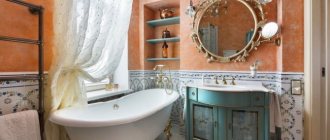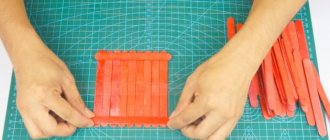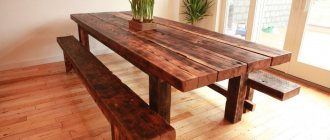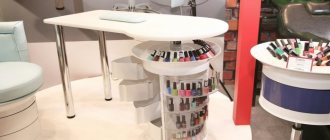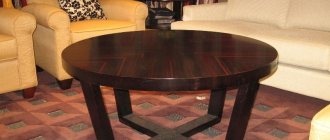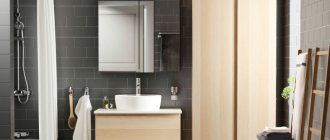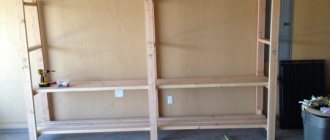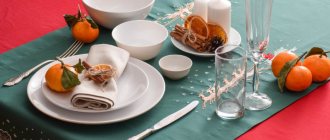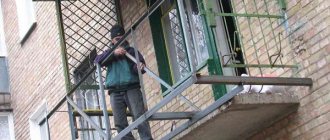Furniture created with your own hands will differ from purchased furniture in its uniqueness and will allow you to take into account your own design wishes, as well as save significant money. Among modern materials used in furniture production, profile pipes are very popular. A table made from a profile pipe for a summer cottage or home will be no worse than a purchased one. This is the simplest design, so it can be done by a home craftsman with minimal skills in working with profiles.
What is an underframe?
At its core, a table base is the base on which the tabletop and all the objects on it rest. Other names are underframe, base, foundation, support, frame.
Do not underestimate the role of the table, since the reliability and durability of the table depends on it. Therefore, you should choose the base for the table wisely. Because if you miscalculate the load, the table may become unstable. And as a result, from an accidental push it will simply roll over.
In addition, a correctly selected table base can become a unique highlight of the interior, which will emphasize the individuality of the room.
Design Features
The welding table is the main workplace of the welder. On a flat metal tabletop it is convenient to perform manual welding, cutting metal, cleaning parts, and final grinding of products. A classic DIY welding table suitable for installation in a garage or workshop. In such conditions, the overall structure serves as a grounding element, since it is entirely made of metal.
Another difference between a workbench and a regular table is its structure. It meets the criteria of practicality and safety requirements. Mandatory elements are a fireproof tabletop, tray and legs. The design can also be equipped with a lower shelf, on which it is convenient to store tools and equipment - a welding machine, a shield, an ammeter, a voltmeter, a pencil case with electrodes. Any welding equipment is manufactured and installed according to safety rules:
- above the table there is a working hood for removing gaseous substances;
- the ventilation device is mounted at a height of 1.3–1.5 m above the welding workbench;
- a copper edging is welded along the edge of the tabletop to keep the grease off the electrodes;
- The workplace is equipped with lamps operating under a voltage of 36 V.
No flammable substances or materials should be stored on or near the table.
What are the grounds?
Many different materials are used to make table bases. According to this, they are divided into:
- wooden;
- metal;
- plastic;
- glass;
- stone;
- combined;
- from MDF and laminated chipboard.
In addition, the underframes are divided by height:
- standard – their height is 72-73 cm;
- bar with a height of 1 m and above;
- coffee tables with a height of 45-50 cm.
By scope:
- for public places (cafes, restaurants, offices, bars);
- for houses and apartments.
The most common types of table supports are metal and wood.
Precautions when working at a welding table
Welding has several harmful factors that can harm human health:
- heat;
- scattering of hot splashes;
- high intensity ultraviolet radiation;
- electric shock;
- falling of heavy objects.
To avoid harmful effects, the following rules should be observed:
- Work must be carried out in well-ventilated areas equipped with both supply and exhaust forced ventilation.
- Before starting work, carefully inspect the equipment for mechanical damage, insulation damage, or loose contacts.
- While working, be sure to use personal protective equipment: welder’s mask, respirator, split-leaf protective gloves with gaiter, fire-resistant clothing and shoes.
- The workplace must not be cluttered. The welder must have easy and convenient access to the work area.
- It is strictly forbidden to work from random supports.
- The parts to be welded must be secured with stock fasteners.
- It is strictly forbidden to use and store flammable materials and liquids closer than 5 meters from the welding site.
Carefully following these rules will preserve your health, life and material values.
When welding small parts, problems arise with their fixation. Subsequently, they will affect the quality of the seam and the reliability of the connection. To solve this, special tables are made, the design of which is designed to improve the convenience of the welder. It is important to choose the right drawing and draw up an assembly diagram.
Wooden bases
Wooden table bases look prestigious, solid and rich. They are considered classics and fit almost any interior. Compared to other options, wooden table bases are much more elegant and look more natural.
The most affordable models are made of walnut, beech, birch, pine, ash, and oak. Expensive models are made of mahogany or wenge. For production, use timber with a width of at least 5 cm.
Bases made of carved oak and other valuable species are almost identical in strength and reliability to steel bases. Among the disadvantages, it is worth noting the high cost and lack of stability.
Wood perfectly emphasizes the sophistication of the interior. In addition, this material is environmentally friendly. A special highlight can be a table stand decorated with paintings or carvings.
The main disadvantage is the high price. In addition, wooden bases require additional processing to avoid deformation when exposed to high temperatures or moisture.
Description of wooden structures
The base for a regular table with a wooden tabletop is made in the form of a frame frame resting on the legs. Most often there are four legs (support posts), but there are products that have one massive leg or three medium ones. A typical representative of such supporting elements are some models of kitchen tables included in furniture corners. They have one flat support, the length of which is slightly less than the size of the tabletop.
The simplest design has a non-transformable base without drawers. Its design contains:
- three or four rectangular, square or round legs;
- the upper, usually made of four rectangular bars, tsar belt;
- fastening elements.
The cross-section of the legs of the kitchen wooden table underframe should not be less than:
- 45.0×45.0 millimeters (square section);
- 60.0×45.0 millimeters (rectangular section);
- The diameter of the round legs is more than 50.0 millimeters.
The width of the drawer board is taken to be 90.0...100.0 millimeters, with a minimum thickness of 20.0 millimeters.
Wooden stands on four legs are not only stable, but also quite practical. They are the basis of kitchen products - transformers. When choosing the appropriate cross-section of the legs, they can support the weight of a tabletop made of any materials. For premium-class kitchen tables, the outside of the drawstring belt can be decorated with carvings or other types of decorative finishing.
In the manufacture of wooden bases, various types of materials are used, the main ones being:
- solid wood used in the manufacture of premium class furniture;
- MDF is a board that is most widely used for most types of kitchen table bases, photos of which are given at the end of the article;
- laminated chipboard is used in the production of budget options;
- for country kitchens and open verandas, they produce combined versions in which a wooden drawstring belt rests on metal (usually tubular) legs.
Kitchen table bases made of wenge wood, stained oak or mahogany look exclusive and expensive. However, the cost of such products is off the charts. Therefore, today a more acceptable option is the production of furniture elements from laminated chipboard, the coating of which imitates the texture of valuable tree species.
If the table is equipped with drawers, then the drawer belt has an increased height. In this case, the width of the drawer board depends on the height of the drawer. The guides for it are attached inside the belt using additional fastening fittings.
During assembly, it is necessary to ensure the reliability and rigidity of the upper belt with legs. This is achieved by making the drawstring belt with orienting grooves, using special connecting elements. The drawbar connection itself provides the required rigidity, but often the fastening of the legs with the drawstring belt is duplicated. For example, an adhesive connection is duplicated with a pin or bolt connection.
Until recently, the design of undertables has not received much attention. It was believed that the base itself was hidden from prying eyes, and the main importance was attached to its rigidity, strength, and ergonomics. Today, with the advent of glass countertops, the appearance of the base also plays an important role, shaping the consumer properties of the product as a whole.
Metal table supports
Perhaps the most popular are metal table bases. Such products are strong, durable and not afraid of mechanical stress. But at the same time, they are quite heavy, which should be taken into account when choosing bases made of this material. And to protect the floor from scratches, use plugs made of silicone or plastic.
To make metal table bases, cast iron, copper, aluminum, stainless steel, and brass are used. As for coatings, most often it is painting. The best option is durable powder paint followed by drying it in an oven. Color solutions can be different: black, brown, white, gray. The last color is quite interesting as it creates the effect of a machined aluminum surface.
The surface of metal bases can be:
- matte;
- painted enamel;
- shiny (chrome or nickel plating);
- tinted (gold, brass, bronze, copper).
Most often you can find a table base made of a profile pipe. They are light in weight and yet quite stable. Tables with such a base are not difficult to move if necessary.
The cast iron base is considered the most durable. It is obtained using the casting method. This option is ideal for outdoor use. In addition, another advantage is the wide variety of shapes. Of the disadvantages, perhaps the most important is the large weight of such a product. Such supports are usually covered with durable enamel.
Stainless steel and chrome-plated bases are preferred when tables are placed in a bar or on the terrace of a street cafe. Such supports are quite stable and have an aesthetic appearance. In addition, they tolerate moisture and temperature changes well.
Polished aluminum table bases have similar qualities to stainless steel. The difference is lighter weight and the requirement for smaller countertops.
One of the most attractive are forged table bases. Although they are expensive, they are still very popular. Such supports easily become the highlight of the interior.
Top 7 metal table ideas
Steel outdoor furniture has become popular since the 20s. Around 1925, Marcel Breuer, a designer and architect, began working with tubular steel, impressed by its light weight and strength.
The returning trend is centuries old - medieval nobles loved wrought iron tables in their homes long before us. There are different types of metal that can be used in making tables, such as iron, aluminum and stainless steel. Today there are a thousand ways to make metal furniture:
- Designs can be very laconic. If you make a stable round coffee table on 3 legs, it will take its rightful place in the house. To create such a table with your own hands, you will need steel hoops and three steel pipes.
- With your own hands, you can create retro-style furniture using wood, which will take you back to those old times, when everything seemed made to last.
- A modern table welded from metal sheets looks both elegant and monolithic.
- It’s easy to make a table for a minimalist interior using square-section metal pipes with your own hands.
- If a light metal structure is complemented by glass elements, then the furniture can seem weightless.
- The shape of a DIY table using 3 wooden planks skillfully carved from a single tree stump can be so complex that it is difficult to replicate. The steel legs in this product are secured with nuts and bolts.
- Those who are tired of the traditional type of furniture can try to create structures, parts of which are held together with thin steel cables. In the Tancegrity structure, not a single element experiences a bending moment.
Design features
Based on design features, the bases are divided into:
- adjustable table supports;
- unregulated grounds;
- folding supports;
- folding structures;
- retractable models;
- supports on wheels.
Adjustable bases are a great option for floors with height differences. They are usually produced with a height of up to 150 cm, but the optimal option for adjustable supports for a table is 100 cm. This design allows you to change the height of the table without any effort. Ideal for cafes, bars, canteens and private homes. Before purchasing, be sure to check the operation of the mechanism, make sure its reliability and find out all the characteristics from the accompanying documents. It is important to always know within what limits you can change the height of the table.
Non-adjustable table bases are produced with a height of up to 1 m, but the most popular bases are those with a height of 50-60 cm. Such models are the simplest and are considered the most reliable. Most often they have four legs.
Regarding legs on wheels, they are most often used for mobile furniture such as a coffee table, cabinet, armchairs.
Folding tables are very attractive in terms of practicality. If necessary, you can fold it and hide it. When choosing, you should pay attention to the reliability of the folding mechanism. Otherwise, you may end up in a very unpleasant situation when the system fails at the most inopportune moment.
Folding bases are the best option when you have to frequently change the number of available seats. They are ideal when you need:
- quickly start a meeting, conference, meeting;
- organize a large audience;
- hold large meetings with a large number of people.
In addition, folding tables are ideal for outdoor events. And the presence of a function for autonomous height adjustment of each leg will help to avoid many inconveniences when the table needs to be placed on an uneven surface.
Retractable structures are an excellent option for small spaces. If necessary, such an underframe can be pulled out and the tabletop expanded. This manipulation will add several seats.
Safety precautions during welding work
Since all stages of the process are directly related to welding, standard safety rules must be followed. They relate to the placement and equipment of the welding station, special clothing, and the physical parameters of the devices. Safety precautions include the following points:
- The workshop must be equipped with a ventilation system. The room must provide for ventilation.
- If welding is carried out outdoors, the workplace should be under a canopy. At the same time, during heavy rain or snowfall, the process is stopped.
- The welder must be dressed in protective clothing, which includes a mask (visor), mittens made of split leather or suede, shoes and a suit made of non-flammable material.
- If welding parts made of galvanized metal is carried out, the craftsman needs a respirator to protect the respiratory tract.
- Welding cables must have an intact winding, and high-quality insulation at their joining points. If a defect is detected, work should be stopped and the integrity of the wire restored.
- The length of the electrical cables leading to the welding machine should not exceed 10 m. The cords are suspended at a height of 2.5 m or lowered to the floor in a grounded steel pipe.
- The equipment can be used at a voltage of no more than 90 V. The optimal current for operation is no more than 0.05 A.
Step-by-step making of a table from boards with your own hands, examples of decor
For a craftsman who has the necessary skills, making a table for welding work is a simple undertaking. The main thing is to follow all safety rules, adhere to the prepared drawing and perform actions in a certain sequence. In this case, the end result will be reliable and stable, and the durable finished product will provide the welder with ease of work for many years.
The workshop must be equipped with a ventilation system, and the room must be ventilated
The welder must carry out welding work in special protective clothing
Welding cables must have an intact winding, and their connecting points must have high-quality insulation
A little about legs
Manufacturers of table bases offer the following number of legs:
- Four legs. This is a classic option that fits all types of countertops. In addition, this number of legs allows you to withstand heavy loads due to the distribution of weight along the entire perimeter.
- Three legs. It also occurs quite often due to its unusual nature. It looks interesting when the legs are gathered at the top and only diverge towards the bottom. In addition, if there are some weird deformations, then this adds even more creativity.
- Two legs. This option is not found often and is considered rather something of a delicacy. For stability, the legs are usually slightly curved in the form of semicircles or pyramids.
- One leg. Also a rare option. Usually a small tabletop is selected for such a support, most often round in shape and made of glass or MDF. To ensure balance, the support must be massive.
In addition to standard forms, there may be various variations:
- rectangular (classic);
- square;
- U-shaped;
- X-shaped;
- W-shaped;
- V-shaped.
In fact, this list can be continued for a long time. And of course, forged bases with their various bizarre shapes. This is where designers often show maximum creativity.
Your view of the world is palpably “frendo”
I ignored most of what you said as I don't have time right now since I'm holding my baby and showing empathy and love reading what I'm sure is a one sided analysis of how men created the world and women didn't do anything contribute
You spent 500 words showing me my gut reaction to your views, and your defense of his post was correct. You are an eloquent writer and are much better at putting compelling arguments into words than I am.
However, between your comments on philosophy and the "evidence" proving that women do not contribute to society, you essentially said that only women are useful to society in those commercials that require "niceness and compassion" - thanks to your clouded view of the world in which you do not understand that you are belittling men in general with your comments, not just women.
Assuming that men can't be as compassionate or as nice as women is a disservice to all men, as is suggesting that a woman can't be as assertive or direct as a man.
Your whole idea of women's contributions to society is based on traditions instilled in you in your youth and emboldened by the echo chambers you choose to immerse yourself in.
Take a second step away from your preconceived notions about how valuable men and women are and think about how, as a society, we socialize male and female children differently. They are treated differently, so it is logical to assume that they will be more competent in different areas. Everyone is encouraged to demonstrate competence in areas that society considers masculine or feminine. This does not mean that there are no differences between men and women, but equally the differences between the sexes are equal as between them.
Also the idea that as a white male (I am a white male too) demonizes us is false. For hundreds of years we have had the privilege. And now much of that privilege is being taken away (and rightly so). The problem with the privileged is that they don't recognize that they have it, and any move away from that privilege is an insult to them and their way of life, the most recent examples being the countless women standing up to the majority of older white men who, thanks to their power and privilege could sexually harass and control women's careers.
And finally, as you casually mentioned, how white men treat their women with “best far away.” Your use of language shows again. Women are not chattels to be “treated well.” And how do you determine how each white man feels about “his woman”? Are we making a comparison to women who are forced to mutilate their genitals? Or women who are oppressed by their religion and society so that they do not share their opinions and hide their beauty through full body coverage so as not to seduce men? Or against those women who are sexually harassed simply by being attractive?
Explain to yourself exactly how you feel we treat women best? When we're dealing with domestic violence and rape and a culture that has people like you who hold the view that women are not as valuable as men. Even if they only mean financially, and to me that's the least compelling argument I've ever heard. To suggest that you can express the value of people simply by how much money they generate or contribute is simply ridiculous.
In closing, I will thank you, as you thank me, for the response and thoughtfulness of your post (even though on several occasions you used language to belittle me). It is clear that we hold very different worldviews regarding gender. I can only hope that you will become more enlightened or at least not spread such demeaning misinformation to any young people you encounter.
Base color
Usually the base is made in the same color as the tabletop. But there are also various combinations. Choosing a color follows the same principle as the rest of the furniture.
The classic underframe has a laconic black color. It is with it that countertops of any color, made of different materials, are combined. In addition, simple unpainted tabletops made of natural wood go well with a black base.
One of the most elegant is the black forged table base. Very often, the legs of such models are decorated with various decorative elements, which, in tandem with an unpainted wooden tabletop, will make an ideal pair. Looks impressive both in the house and in the yard.
White color looks attractive with glass and is used most often in modern and high-tech styles.
The classic brown color does not look as catchy as black and white, but still looks quite attractive and harmonious.
If the metal is not painted, then the most successful combinations will be with white, black and beige. But it’s better not to combine it with a gray tabletop to avoid blandness.
Chrome table bases are ideally combined with glass or other materials coated with gloss, provided that the color matches the interior.
Warm shades make the space a little wider. If the windows face north, then the best solution would be to choose peach and beige tones.
Progress
Before creating metal structures with your own hands, you need to carry out careful preparation. Only after adapting the drawing and acquiring the necessary materials and tools can you begin assembly:
- The pipes are marked and then cut according to the diagram. The simplest designs are assembled from one long, 4 short elements and 4 legs.
- The table frame is created using welding or bolts; all corners of the structure must be straight. After this, spacers are installed.
- The seams are cleaned and covered with a layer of anti-corrosion compound.
- A tabletop made of boards or tile materials is installed on the finished frame. The surface is carefully treated with a grinding machine.
- The tabletop is fixed with screws. To do this, holes are first drilled in the metal frame.
A variety of unusual tables, non-standard shapes, colors and materials
In the same way, you can make chairs with your own hands. If the metal structure will be placed indoors, special rubber attachments are placed on the tips of the legs to protect the floor covering from scratches.
The easiest way to install a tabletop involves using wood glue, but fixing it with bolts and self-tapping screws is the most reliable.
Make markings and cut the profile pipe in accordance with the diagram
Weld the table frame
Clean the seams and coat the structure with an anti-corrosion compound
Sand the surface of the tabletop with a sander
Place the tabletop on the frame and secure with screws
By analogy, chairs can be made from a profile pipe
Special rubber nozzles for the legs will protect the flooring from scratches
How to match the interior?
Before purchasing a table, you should take into account the overall interior design; in addition, you need to look at the purpose of the room.
When choosing bases for a bar, you should pay attention to chrome-plated bases. The combination of a telescopic base with a round glass tabletop or other unusual material looks good. A cafe equipped with tables with different tabletops, but the same supports, looks harmonious and interesting.
Often designers use cast iron and wood bases to decorate restaurants. This is due to the fact that such underframes look great in dim lighting.
If the tables are placed outdoors, then cast iron bases or a lighter option – aluminum bases – will look aesthetically pleasing. In addition, this solution is more practical.
Products for exhibitions are mainly made of aluminum. They are easy to install and dismantle, which saves a lot of effort and time.
In an apartment or house, you should pay attention to the color schemes of the room where the table will be located. For example, elegant and miniature bases are perfect for a bedroom. But in the dining room a durable and massive table will look great.
If the room is decorated in a classic style, then a wooden base would be appropriate. And for high-tech rooms, the ideal option would be a chrome base or plastic.
For a glass table, it is better to choose a base made of aluminum or brass. In addition, painted cast iron will look harmonious.
For a minimalist design, you can choose a base made of glass or thin metal. In this case, it is better to equip such a table with wheels so that, if necessary, it can be easily moved to another place.
If the main idea in the interior is rustic, then it is better to use rough wooden elements (for example, untreated bars, logs) paired with a round or oval tabletop.
For the loft (industrial) style, the best option would be to create the appearance of a rough and untreated surface. This style requires that the furniture be durable in appearance, one might say, create an appearance of indestructibility.
A luxurious retro model will look elegant and harmonious in a classic interior. The same option is acceptable for Provence. But in a high-tech style it would be inappropriate. Products using ball paint are well suited for marine styling.
Baroque is characterized by gilding and a certain pomp in decorating elements. But at the same time it should be easy and elegant. Therefore, bases with a touch of gold will look appropriate.
What else is needed for the kit?
To create the most comfortable working conditions, you will need to buy additional tools for the welder. Their function is reliable fixation of the workpiece and the ability to quickly change its position. Requirements: resistance to temperature changes, mechanical strength.
A set of additional tools:
- Clamps. Necessary for fixing the workpiece on the surface for precise welding;
- Clamps. They perform the same function, but in a more specialized manner - installation requires an angle between the parts being welded, a complex connection.
- Magnetic base. Recommended for processing small-sized parts, the fixation of which is difficult mechanically.
In the latter case, it is necessary to take into account the mass of the auxiliary magnetic tool and the maximum permissible weight of the part.
The video provides a detailed overview of the optimal table model for a welder:
Tables with lacquered top on a metal frame
Necessary materials:
1. Lumber; 2. A sheet of plywood 1.5 cm thick; 3. Beam; 4. Nails, screws and plugs for them; 5. Wood glue; 6. Epoxy resin (5-7 liters); 7. Masking tape; 8. Metal profile (about 9 m); 9. Spray paint (for metal); 10. Oilcloth and other materials.
How to choose a base?
When choosing bases for a table, you should focus on the following points:
- The general interior of the room, with which the design of the underframe should be combined.
- Support height: this will be an exclusive coffee table with exquisite legs, a bar counter or a table at which to sit while eating.
- The quality of the underframe. One of the important criteria when choosing. When choosing a metal base for a table, you should pay attention to the welding seams, the quality of painting, and the level of fixation of the upper platform (the part where the tabletop is placed). When choosing a wooden base, it is important to pay attention to the quality of wood processing, the presence of varnish, and the method of attaching the support elements to each other. The best option is bolt fastening.
- Well, and, of course, an important factor is the price of the product.
In fact, supports must have the following characteristics:
- sustainability (this is the very first thing you need to pay attention to);
- durability;
- Possibility to use both indoors and outdoors;
- withstand the weight of the table top and the objects on it, plus the weight of several people leaning on it;
- attractive appearance;
- ease of care;
- anti-corrosion coating.
If the choice of tabletop fell on heavy materials such as stone or on large tabletops, then the bases also need to be selected with a large size and weight.
Tables over 1 m are less stable due to their height. And all because the center of gravity of such under-tables is shifted closer to the top, and that is why the tabletop needs to be chosen smaller than for standard tables.
Another nuance is the location of the supports. They can be placed either in the center or in the corners of the tabletop (along the perimeter). The latter option gives greater stability. But still this is an additional hindrance for the legs, especially if the room is small.
It is worth thinking about moving the table in advance. If it will be moved frequently, then you should pay attention to light and compact products, perhaps even folding ones. If, on the contrary, the table does not move, then it is better to give preference to wood or cast iron.
Views and drawings
Depending on the design, all welding tables intended for private workshops are divided into two types: simple and semi-professional. For temporary or simple work, the first option is suitable. For the manufacture of complex products, a semi-professional (rotary or assembly-mounting) design is required.
The easiest way is to make the first type of welding table with your own hands. A simple model consists of a rigid rectangular frame to which four supports are welded. As the latter, use a corner or a steel pipe. For greater stability, the legs are fastened around the perimeter with metal crossbars. The tabletop of a simple table is equipped with perforation grooves for securing the parts to be welded.
The design of the semi-professional workbench is equipped with a round platform that can rotate smoothly. Movement is possible thanks to the installed electric motor. This model allows the welder to create complex products without moving around the furniture. The assembly and assembly table provides additional built-in elements: head devices for drilling, grinding, milling, as well as a built-in fan.
For self-installation, you must prepare drawings of the device. All details must be drawn on them with exact dimensions. If there is no ready-made option, drawing up a drawing of the welding table is done manually. To do this, create a bill of materials. A summary table with table dimensions and names of materials is reflected on one sheet with the sketch itself. When making calculations, it is taken into account that the height of the workbench should be within the range of 700 to 850 mm, and its area should be at least 800 × 1000 mm.
Simple
Semi-professional
Assembly and installation
Drawing
Rotary table Ф -125mm. (what can be made from scrap metal)
I have two “Chinese” ones: a milling machine - X1, which I keep and on which I remove up to 0.5 mm per pass, albeit with an F36 cutter.
And a turning 7x14, which I also use sparingly and don’t remove more than 1mm per pass. on steel. For diameters over 100mm
I don’t remove more than 0.5 mm per pass. — The power of the electric motor is not enough.
I am providing this information so that they don’t think that I have some super-duper machines. Moreover, I will say that they are both substandard. True, adjusted by me.
About two years ago I started collecting scrap metal for a turntable.
I then had one 16TO2P machine, which I bought at the dawn of perestroika, then I tinkered with something and abandoned it - I had no time for it. And about 2 years ago I took up it again. And then I needed an accurate divider.
Then I went to scrap metal and found this:
Judging by the design, it was a small globe table, completely new, but disassembled to the ground. Of course, there was nothing nearby that looked like a worm gear, and there was no worm either...
I picked up the countertop anyway and brought it home. As time went on, the situation changed. I desperately needed a turntable.
This summer I found a worm gear with 36 teeth. She's in the picture below. And soon, two weeks later, I found a worm for her.
I've been looking for a ball bearing for a tabletop for a long time. It turned out that such a bearing exists in the aviation industry, but its price is twice as much as buying the coolest round table for a hobby machine abroad with delivery.
In short, about two months ago I found a dead worm gear of suitable diameter on scrap metal:
I decided to make a sliding bearing out of it under the tabletop.
The result was only a blank for a sliding bearing.
Then, accordingly, I machined the tail of the tabletop on the faceplate and modified the worm gear.
Happened:
I left the teeth of the old gear as a design squeak.
The table body was made from a plate 8mm thick. I found a 400x400 sheet of scrap metal and agreed to have it sanded “as clean” in thickness using a flat grinder. It turned out 7.22mm
I cut it into plates with a hacksaw, then strictly milled all the plates to the same size in terms of dimensions with an accuracy of 0.01mm.
I drilled holes for fasteners with a short drill according to the coordinates, and on a machine I cut M4 threads and chamfered countersunk screw heads. Everything fit together as it should. The dimensions of the table body after assembly in terms of thickness were within 0.02mm
Since the life history of the worm pair is unknown to me, and I had nothing special to check their geometry, I assumed that radial runout of both would certainly take place. To improve the accuracy of the table, I had to secure the worm “softly” in relation to the worm gear. To do this, we had to make a “catcher” for the bearing, a clamp and two shock absorbers on both sides of the worm. — On one side, the shock absorber has a spring on the rod, on the other, place a 1.5 mm polyurethane washer under the bronze screw.
This approach allowed us to solve two problems: the first was to get rid of the harmful effects of the mutual radial runout of the worm pair and ensure smooth running of the table; second, it became possible to disengage the worm when adjusting to the center of rotation of the base hole of the part.
To ensure rigid fastening of the worm on the limb side, I installed a hinge bearing.
Everything else in the photo:
Table dimensions 130x140x78 without protruding parts.
The end runout of the sunshade is less than 0.01 mm
Non-parallelism of working surfaces (bottom, top) - about 0.03mm
Labor costs - 1 month of complete creative buzz.
There is not a single sketch or drawing. One piece of paper where I counted chains of sizes and memorized especially necessary sizes.
